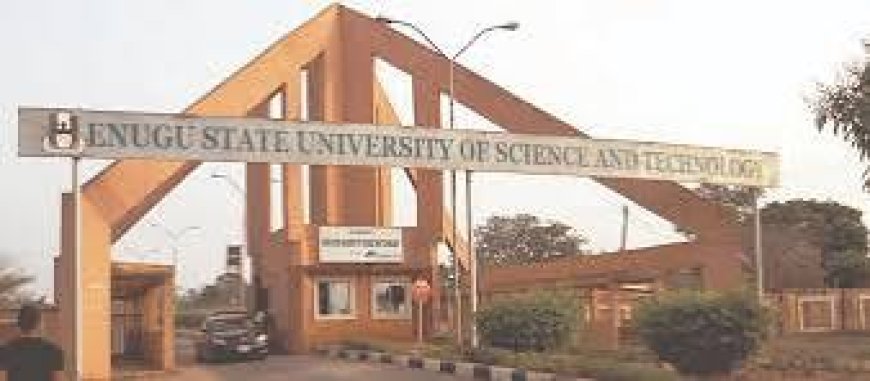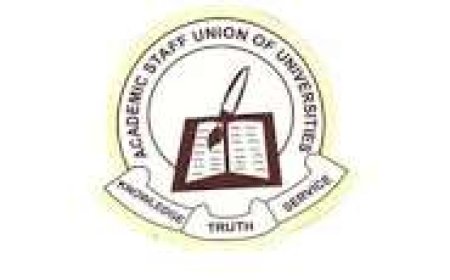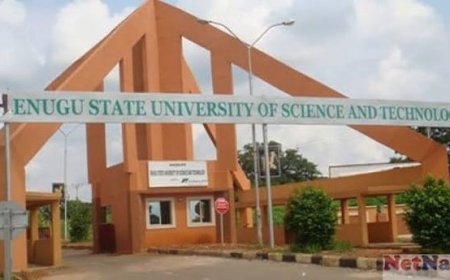ESUT’s Growth Paradox: Unpacking The Obstacles
The Enugu State University of Science and Technology, ESUT, stands as a beacon of academic excellence, proudly holding the distinction of being the first state university of technology in Nigeria

By Our Reporter
The Enugu State University of Science and Technology, ESUT, stands as a beacon of
academic excellence, proudly holding the distinction of being the first state university of technology in Nigeria. This remarkable achievement, which dates back to its founding in 1980 by the old Anambra State Government of Jim Ifeanyichukwu Nwobodo, marks the beginning of a journey rooted in innovation and academic prowess.
Over the years, ESUT has flourished, expanding its reach with two campuses in Awka and Ebonyi, both of which
have since grown into independent universities. The institution’s legacy is further enriched by the notable achievements of its early alumni, whose contributions continue to elevate
ESUT's standing in the educational landscape.
However, a closer look at the current state of the university in Agbani reveals a troubling reality. The institution operates far below the standards expected of a leading university in the 21st century. Despite growth in student enrollment and program expansion, ESUT appears content with meeting only basic, minimal standards, lacking the ambition and
innovation needed to thrive in a competitive academic environment. This complacency undermines its potential and hampers progress, keeping it from reaching the heights it is capable of achieving.
There is a striking lack of bold, innovative initiatives that could propel the institution to the forefront of higher education in Nigeria and beyond. Rather than embracing the dynamic, forward-thinking trajectory of modern global academic standards, ESUT seems hesitant to take the necessary steps to distinguish itself. As a result, despite its 45 years of history, the university has yet to carve out a unique identity that aligns with the global best practices in higher education. This reluctance to evolve and innovate has left ESUT in a stagnant position, one that undermines its potential and legacy as a pioneering first generation state university in the Nigerian academia.
Few indicators will provide a panoramic view of the situation. Despite being in existence for 45 years as of 2024, the Enugu State University of Science and Technology, ESUT, can only boast of delivering fewer than about 45 inaugural lectures, 20 of them coming in the last two years with the persistent prodding from the present Vice-Chancellor, Prof.
Aloysius Okolie, a brilliant Fulbright scholar and an export of the University of Nigeria.
This is despite the university having announced over 350 professors since inception.
Furthermore, with the current Vice-Chancellor’s push, faculties have suddenly jolted to life in mounting conferences. Though most of these conferences are referred to as "international” in nomenclature, their content and attendance can best be described as a local institutional academic gathering.
In the realm of public lectures, the university, which had long been completely dormant,
seems to have awakened. It recently hosted thelllll LLP LLP chartered LLP LLP po first true distinguished personality lecture delivered by the Enugu State Governor, Barr. Dr. Peter Mbah on the topic "Experiential Learning: Building the Wealth of a Nation." This well-packaged lecture was preceded by another remarkable lecture delivered by the Secretary to the Enugu State Government
on “Leadership and Strategic Planning in Tertiary Institutions in Nigeria,” organized by the university’s Directorate of Academic Planning. While these steps are commendable, they do not mask the fact that, despite the Vice-Chancellor's gregarious efforts to position
the university for success; the entire system remains bogged down by the sectional biases of the university’s top brass and oversight establishments.
Despite being Nigeria’s pioneer state university of technology, ESUT remains
conspicuously absent from the Times Higher Education (THE) global university rankings.
Its academic footprint, as measured by webometric standards, falls woefully short, not even qualifying for a mention, let alone a rank. At the heart of this stagnation lies an outdated system of academic appraisal and professorial assessment, still shackled to the antiquated and dysfunctional 'ESUT Green Book'. A moribund document that blatantly ignores globally accepted metrics like Google Scholar citations and other internationally acceptable evaluation domains. Efforts by the current management to implement a
revised new “Conditions of Service” for academics have repeatedly crashed against the wall of sectional self-interest, driven by fears of whose privileges might be threatened. Bishop Hassan Kukah’s biting observation that 'our universities have become a playground for the sectional proclivities of local elites' rings especially true in this regards. Records reveal a disturbing trend at ESUT concerning the publication and sale of books.
Despite the hefty sums disbursed by the Tertiary Education Trust Fund (Tetfund)
specifically for academic book publication, a dishearteningly small number of lecturers from ESUT have been able to access this support. This is primarily because their
manuscripts are riddled with mediocrity. Instead of striving for scholarly excellence, many have entrenched a lazy and toxic culture of self-publication, bypassing peer review and
flooding the university with poorly written, intellectually bankrupt books. These
substandard and often plagiarized tomes are then brazenly imposed on students and sold at obscene prices with no regard for academic integrity or student welfare.
It is estimated that more than 10,000 such worthless publications plague the shelves of ESUT, forced upon unsuspecting students by lecturers who have turned this racket into a lucrative side hustle. This shameless practice has calcified into a perverse norm, poisoning the academic climate of the university. Only a few faculties, perhaps Medicine, law and Pharmacy, have managed to resist this rot.
Most alarming is the fact that young lecturers, themselves products of this decaying system, now perpetuate it with renewed zeal. Having grown up under its shadow, they return as faculty, not to reform, but to reinforce this intellectual vandalism. As our people wisely say: “when evil becomes a generational cycle, it masquerades as tradition”. And foul traditions, once entrenched, are the hardest to dismantle.
To constantly keep track of academic activities, the National Universities Commission, NUC) ïrecommended that universities should have two Deputy Vice-Chancellors (one for academic and one for administration). A further third is recommended if the university operates a recognizable campus outside the main administration. All universities in
Nigeria with the exception of ESUT have keyed into this vital NUC recommendation. ESUT, perhaps, is the sole university in Nigeria presently operating with just one Deputy ViceChancellor (Administration), despite the overwhelming and crushing burden of academic responsibilities that are relentlessly bearing down on the Vice-Chancellor.
This situation is further exacerbated as the Vice-Chancellor is fiercely combating the
alarming and rampant corruption of money-for-marks practices, which has insidiously been a usual practice in the system. The Vice-Chancellor’s unwavering commitment to cleaning up this pervasive and deeply entrenched rot is evident, as he strives to restore integrity, transparency, and accountability to the institution. However, the strain of managing these crucial efforts, alongside the day-to-day demands of the university, is becoming increasingly unsustainable. The glaring inadequacy of leadership support at the
academic administration level leaves the Vice-Chancellor shouldering enormous,
disproportionate load, even as they courageously battle the corrosive culture that threatens to undermine the very foundation of academic excellence and integrity.
Universities the world over tap into the benefits of appointing emeritus professors as a means of shoring up increased visibility, enhanced reputation and online archival resources. Despite its 45 years of existence, ESUT has yet to bestow the prestigious title of “Emeritus Professor” upon any of its retired professors, a deeply troubling and undermining development. This glaring omission can only be interpreted in two possible
ways. First, it could suggest that the university has failed to produce any professor of international renown and caliber. Second, it might indicate a structural failure within the institution itself, one that has neglected to recognize the vital role such esteemed appointments play in elevating the university’s global standing and visibility.
A thorough analysis reveals that the latter is undeniably true. ESUT is an institution with a proud and distinguished history: it produced the Supreme Court Mace, replicated and manufactured engine pistons in the 1980s, and was the first to establish the ESUT Business School, well before the now-popular Lagos Business School. Moreover, ESUT’s first Vice-Chancellor, Professor Kenneth Dike, was a globally respected scholar who laid
the foundational framework for the university’s academic excellence. The absence of such key recognitions for its distinguished professors undermines the true potential of ESUT’s international prestige and contribution to academia.
ESUT’s administrative structures are mired in outdated and economically restrictive
frameworks that stifle the university's academic potential and hinder its growth. The Governing Council, which should serve as a policy guiding force for the institution, is overwhelmingly composed of political appointees, with a meager representation of only two individuals from the university senate and one from the congregation. This paltry academic input severely limits meaningful discussions, impeding the development of a forward-thinking academic strategy. In contrast, most other universities feature between 4-6 representatives from their senate and congregation, two to three deputy vicechancellors and a vice-chancellor ensuring a richer, more diverse academic input into its policy decision-making processes.
The glaring question remains: why does ESUT continue to operate under archaic
structures designed when the university had fewer than 2,000 students and a staff of less than 300? Today, with an enrolment exceeding 80,000 students and a staff capacity of over 2,500, the university’s management structure remains woefully inadequate to grapple with the dictates of modern day institution. This failure to evolve is not just a structural problem; it is a fundamental barrier to the university's development, hindering its academic ability to compete and thrive in the rapidly changing world of higher education.
Following from the iconic lecture of the Governor on “Experiential learning as the bane for the transformation of education in the 21st century”, it becomes necessary that a cursory look is taken into the fabrics of our tertiary institutions and improve their capacity to work within the precincts of digital experiential learning. The Governing Council is crucial in this rejigging process.
Truth be told, the current Vice-Chancellor has, without a doubt, introduced series of
transformative measures that have strengthened the foundational academic framework of the university. Prior to this, the institution was severely hampered by a dual affliction: an abundance of academic personnel with subpar academic orientations, coupled with deeply entrenched sectional interests that plagued decision-making processes. Under the
leadership of the present Vice-Chancellor, strides have been made to confront these
issues, but the task remains monumental.
In about two years, the current Vice-Chancellor will conclude his tenure, and the university may be left still grappling with a substantial majority of mediocre staff deficient in the requisite academic culture of a progressive institution, unless the Governing Council takes immediate and decisive action to support the Vice-Chancellor in steering the institution toward a more promising future. Without concrete measures to address the
growing academic deficiencies, ESUT risks continuing its stagnation.
In the current digital era, universities around the world are utilizing every advantage to enhance their online visibility and academic rankings, with some even appointing senior management roles to oversee research and webometric initiatives. Unfortunately, ESUT’s
leadership has not recognized the critical role these innovations play. Furthermore, the failure to consider requisite senior management positions and Emeritus Professorial appointments of notable academics further diminishes the university’s academic prestige.
By neglecting these opportunities, ESUT risks falling behind in the competitive global academic landscape, leaving its full potential untapped and its legacy weakened.
The current Visitor of the institution is recognized for his firm and decisive leadership. Now is the time for him to back the management in driving sustained growth and relevance, ensuring that ESUT embraces progressive strategies that aligns its management with the evolving demands of modern academia.
What's Your Reaction?
































































